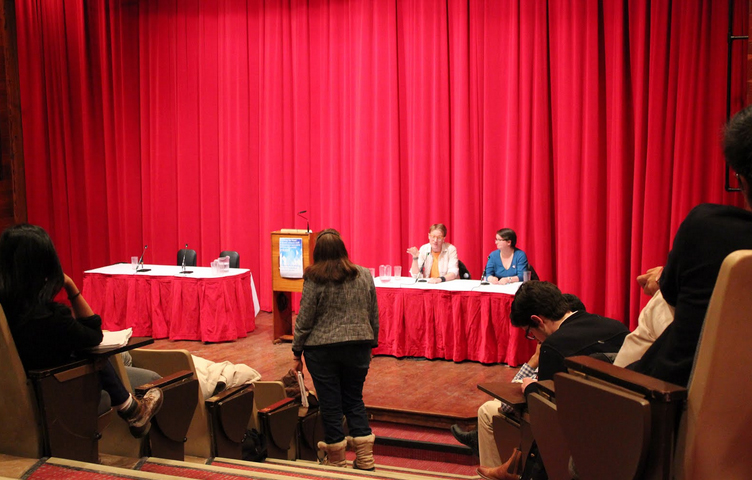By Nathaniel Jote and Liam Fox
Tensions are running high at the University of Toronto between administrators and CUPE 3902, the union which represents 7000 T.A.s and sessional lecturers on three UofT campuses.
During 2014, Units 1 and 3 of CUPE 3902 both had their collective bargaining agreements with the university expire. However, the University has shown little interest in negotiating new ones. In the face of intransigence from administrators, both Units have set a strike date of February 27. If collective bargaining agreements are not successfully signed by then, a large part of the teaching activities at UofT will temporarily cease.
A townhall held last Wednesday night at the George Ignatieff theatre, just south of Bloor and St. George, clarified the issues. Originally, it was organised as a forum for both CUPE and University representatives to explain their positions. A mere two days before the event, however, the University e-mailed organisers and notified them that it was refusing to participate. The peculiar reason provided was that “[negotiations] have not reached an impasse.”
This statement appears to bear little relation to reality. CUPE representatives Erin Black and Ryan Culpepper say that the University is resisting setting meeting dates on which both sides can negotiate.
“They’ve claimed [that] virtually every unionised group on campus is bargaining this year,” said Black in an interview, “[but] they’ve known that we’ve been coming for three years, and could have prepared better.”
Culpepper added: “But right now they’re not meeting with us and there’s no other unions bargaining. It’s just us and they’re still not meeting with us.”
Far fewer meeting dates have been set during this round of negotiations than in previous years. But so far it’s unclear why the university is uninterested in negotiating.

Empty chairs at empty tables: UofT representatives neglected to even show up on Wednesday.
Units 1 and 3 of CUPE 3902 are composed of different parties. Unit 1, with about 6000 members, represents mostly teaching assistants, who are almost all either graduate or undergraduate students at the University. Unit 3, with about 1000 members, primarily represents sessional lecturers.
Labour conditions for workers in both Units are no longer tenable. A minimum funding package for all PhD students at the University was won during the last CUPE 3902 strike in 2000, according to organisers. But this $15 000 per year stipend falls well short of the poverty line in this city, estimated at $23 000 per year.
“People are broke,” said Culpepper, “they’re broke and they’re overworked and they’re exhausted and they’re exasperated….they feel like they’re out of options.”
Despite inflation and rising tuition costs, it has been seven years since the last funding package increase. Furthermore, the package runs out after five years, forcing many students to search for other sources of funding. The goal of CUPE Unit 1 bargainers, therefore, is simply to get their members above the poverty line.
Sessional instructors, members of Unit 3, make on average about $7500 per half-year course they teach. If they manage to teach two courses per semester, which demands hours equivalent to a full-time job, they can make about $30 000 per year, plus a meagre $300 in benefits.
During the question period at the townhall, one speaker observed that the highest-paid person at the University (Jim Moriarty, who manages the UofT asset corporation) makes $750 000 per year, while President Meric Gertler, who because of his position has a residence provided by the University rent-free, makes over $400 000 per year.
Another student commented on the similar quality of instruction provided by sessional lecturers compared to tenured professors. She had taken a philosophy course one year from a tenured prof, and sat in on a lecture for the same course a year after, finding the experience “pretty much the same.” But, she pointed out, the University had to pay that professor almost $300 000 the year he taught that course, and only $7500 to the person who taught it a year later. “That’s not equal pay for equal work.”
The University’s media division did not respond when reached out to for comment.
Comments

Pingback: Labour strikes across Toronto universities | BASICS Community News Service